“Ride the Movies”
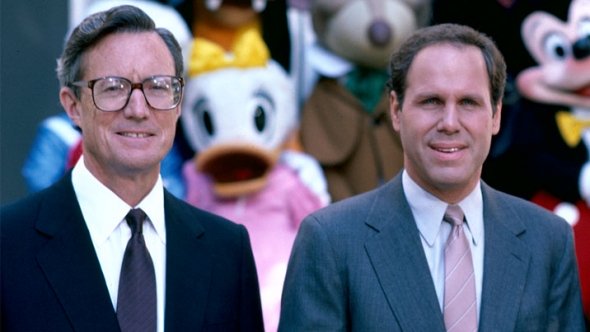
Yes, it’s time for the introduction of a familiar cast of characters in many of our Lost Legends entries; pivotal figures around whom so much of Imagineering history revolves. When Frank Wells and Michael Eisner were brought to Disney in 1984 as president and chairman, respectively, the duo found themselves captaining a sinking ship.
Nearly 20 years after the passing of Walt Disney, the studio that bore his name was at an all-time low. With no new content or revenue being generated by the live action or animation studios, Disney’s parks were stagnant and tired, lacking the relevance and excitement that Tony himself recognized was gone. Though Wells and Eisner were cinematic pros (with extensive histories at 20th Century Fox and Paramount Pictures, respectively), they knew significantly less about theme parks.
That’s why Michael Eisner made a fateful trip to Imagineering on September 29, 1984 to learn more about it. With his preteen son in tow, Eisner showed up to the Imagineering offices and warehouse in Glendale to figure out what designers were working on. And boy was it incredible…
Ventureport
The incredible and ultra-rare concepts that designers cooked up for using Star Wars in Disney Parks in the early 1980s have to be seen to be believed. But at least as far as Tony Baxter was concerned, using George Lucas’ sci-fi mindset to reimagine Tomorrowland would be a coup. In fact, plans called for the park’s Carousel Theater (still playing “America Sings!” leftover from the bicentenntial in ’76) would disappear entirely.
In its place would rise a prismatic glass structure (see the concept art above) leading to an indoor sub-land– Ventureport. (Apologies for all the Passholder-exclusive art in this section, but this is very cool and very rare stuff…)
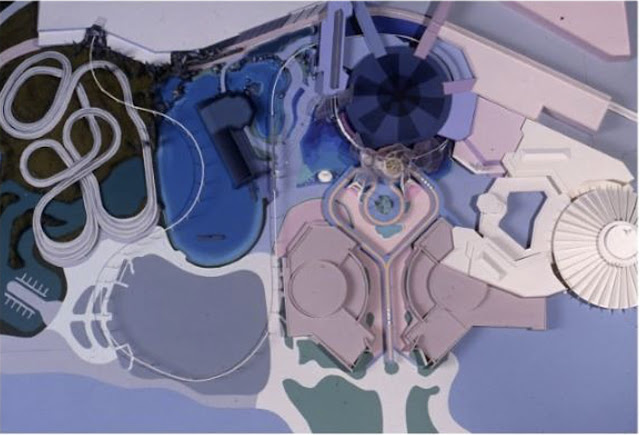
In fact, the crystal entry would merely be the point from which three pathways would diverge, leading to massive showbuildings squeezed into every square foot of allowable space between Tomorrowland Harbor Blvd. What would’ve been inside of them? If you’re interested, that could make a great story here on Park Lore…
But the primary product that Tony Baxter and the Star Wars-focused team at Imagineering wanted to show off to Michael Eisner was perhaps the most ambitious ride ever designed.
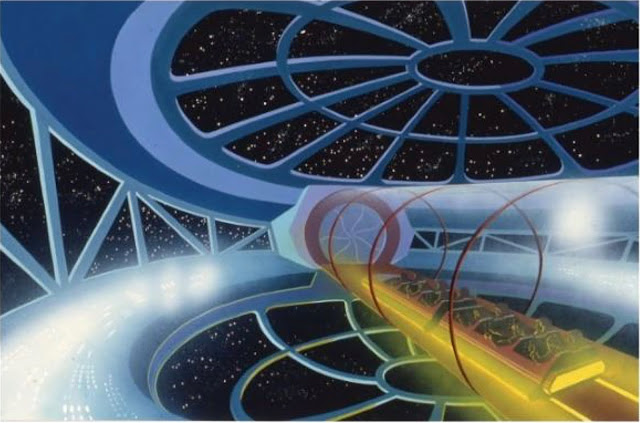
Given that Big Thunder Mountain and Space Mountain had proven the adaptability of roller coasters, it should be no surprise that Baxter and the team envisioned a roller coaster as the backbone of a Star Wars ride. Yes, even mere feet from Space Mountain itself, they’d envisioned a new kind of ride through the stars. What made it special?
This roller coaster would be one of a kind. Designers had mapped out an attraction that would give riders access to all of the Star Wars universe – the light and dark side.
Throughout this ride, there would reportedly be three occasions where guests would slow or stop to view a dark ride scene, then be offered a choice – for example, fight or flee. “Voting” via in-vehicle buttons, the coaster’s track would realign with a new path, launching onward into new scenes. In other words, this coaster would’ve been entirely interactive, with branching segments encouraging re-ridability.
While all parties adored the idea, it had a few fatal flaws. First of all, it would’ve been massive. Essentially containing six separate roller coasters, the ride would eat up enormous real estate in the miniscule Disneyland and necessitate the construction of a showbuilding larger than any Disney had imagined before.
Second, it would take a very, very long time to create – entirely antithetical to Eisner’s hopes for reviving Disney Parks fast. He wanted cool, hip, trendy, and popular movies to turn Disney Parks into pop culture paradise ASAP, and the idea of such an ambitious and expensive project taking the better part of a decade was unthinkable.
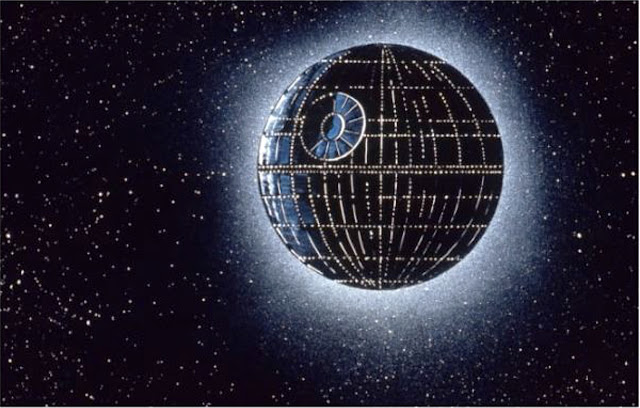
Third, the technology that would’ve powered this ride – transfer tracks, coaster cars diverting down spurs, powered guest interaction in vehicles, and control systems to monitor everything – just didn’t exist (and arguably, it would be a stretch today). Designers had concepted something that was beyond the capability of the era’s technology, just as Baxter had once envisioned a simulator ride before it was even possible a decade earlier!
… Wait a second.
Technology catches up

So while the ultra-ambitious Star Wars roller coaster project was officially off the table, there just might have been a solution to their problems. That “motion simulator” Baxter had hoped for back in the ’70s was no longer the stuff of science fiction.
Enter he ATLAS – Advanced Technology Leisure Application Simulator. One of our Seven Modern Wonders of the Theme Park World, the ATLAS reconfigured military-grade flight simulator technology for the purposes of entertainment. Holding forty guests, this enormous pod was parked atop a six-degrees-of-freedom motion base (forward and backward tilt; side to side roll; and left and right yaw), offering the ability to move 35 degrees in the X, Y, and Z planes. It could lean, pitch, lift, drop, bank, and twist in place, simulating speed, suspension, acceleration, turning, dipping, climbing, and more.
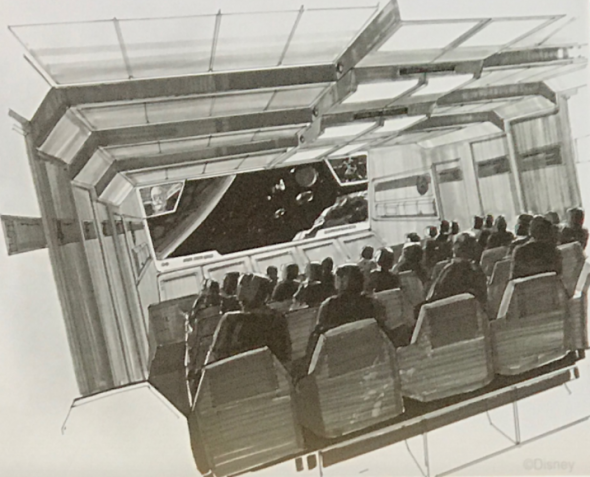
It stood to reason that the ATLAS could be the solution… It would take up practically no space whatsoever; it could take guests throughout the Star Wars universe using multi-media projected into the cabs; and best of all for Eisner, it could come online quickly.
Disneyland’s Lost Legend: Adventure Thru Inner Space closed on September 2, 1985. The roof was removed from its showbuilding along Tomorrowland’s entryway and four ATLAS simulators (purchased for $500,000 each) were lowered in and installed. A new, raised roof was constructed to allow for each pod’s range of motion – still visible today from the air. (That new vertical expansion to the building was adorned with light Victorian accents visible from the Hub and Main Street, U.S.A.)
Disney also created and installed full-sized props, sets, and animatronics, including four copies of the ride’s pilot, RX-24 (one for each Starspeeder). Originally, designers proposed that this pilot – affectionately known as Rex – would have the personality of a grizzled, burnt-out Vietnam veteran who’d be triggered by horrible memories of the war and unintentionally put riders in jeopardy.
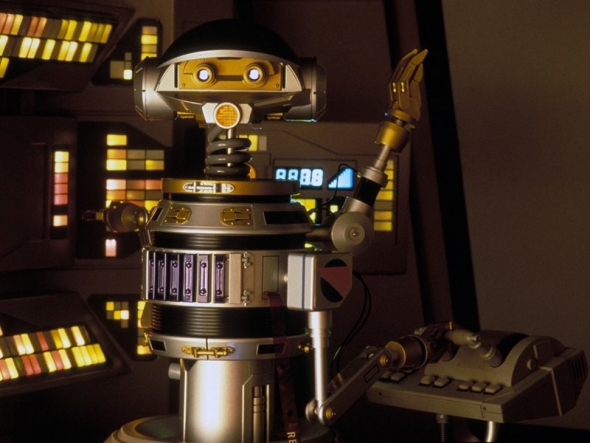
Ultimately, it was decided that the unhinged pilot would be too intimidating for families, so he was reimagined as a well-intentioned and eager rookie who just couldn’t quite seem to get anything right – now regarded as one of the best “original” characters created for Disney Parks. For this Rex, they found the perfect voice actor: Paul Reubens, best known for his role as Pee-wee Herman.
While Disney installed the pods and readied the ride building, George and his team at Lucasfilm were moving forward, too, working alongside Industrial Light and Magic (ILM, the brilliant designers behind many modern movie wonders) to develop models, sets, and special effects for the ride. Even though CGI was in its early stages at ILM, Star Tours was shot the “old-fashioned way” using practical models, miniatures, and computer-controlled cameras — just like the Star Wars feature films – as seen in the rare, Passholder-exclusive production photo above.
Ultimately, the $6 million, 5-minute ride video was shot on 70mm film at 30 frames per second (for flicker-free images). At the insistence of Disney Imagineers, the ride culminated in a trench-run through the Death Star (just like the finale of the film) allowing guests to become the heroes of the story they knew and loved.
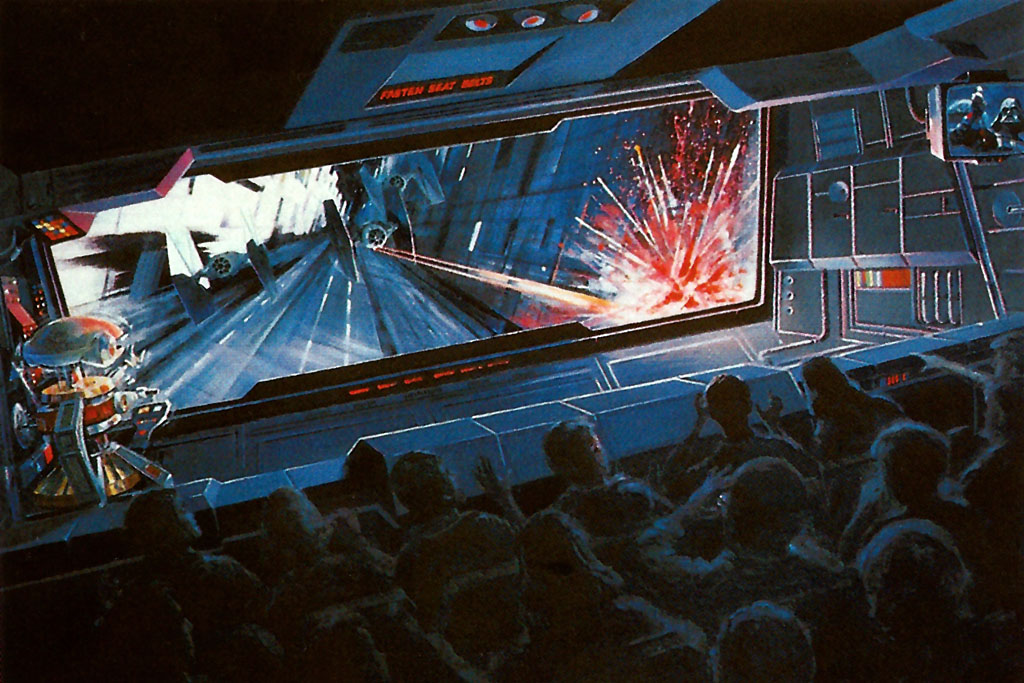
With the pods in place and the 70mm ride film installed in rear-positioned projectors inside the simulator, Disney Imagineers had the enviable (and nauseating) task of sitting in one of the pods with a joystick, manually programming the movement of the pod along the ride film over and over and over to perfection. (After all, it’s the well-synchronized relationship between the visuals and the movement that prevents motion sickness… if what the inner ear felt was even slightly off from what the eyes saw, guests would make a mess of the ride right out the gate.)
Intergalactic opening
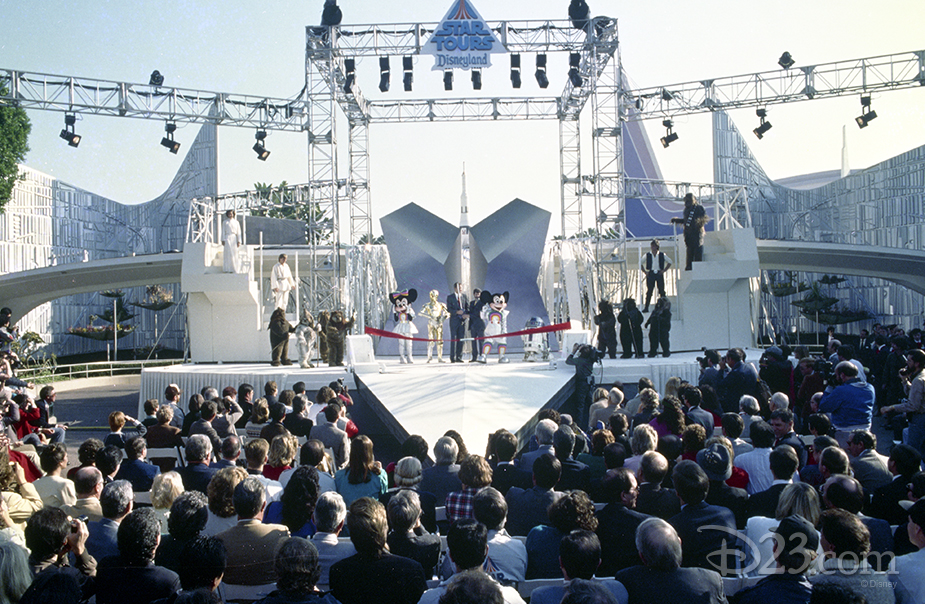
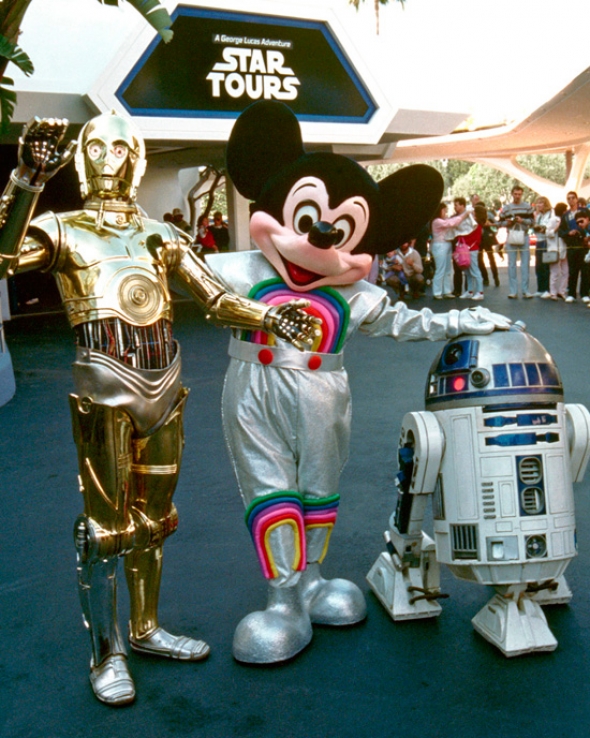
Star Tours opened in Disneyland Park on January 9, 1987. The star-studded event brought Michael Eisner, George Lucas, Mickey Mouse (in his best EPCOT Center space suit), and a literal army of Star Wars characters to the new space terminal in Tomorrowland, prominently set among the land’s main entry under the sleek white highways of the Peoplemover.
In celebration of the grand opening, Disneyland remained opened for 60 continuous hours, from 10 AM January 9 through 10 PM on January 11th. (And you thought the 24-hour parties were wild.) Altogether, the ride has cost a reported $32 million.
What awaited guests within the original Star Tours? Let’s head inside…







